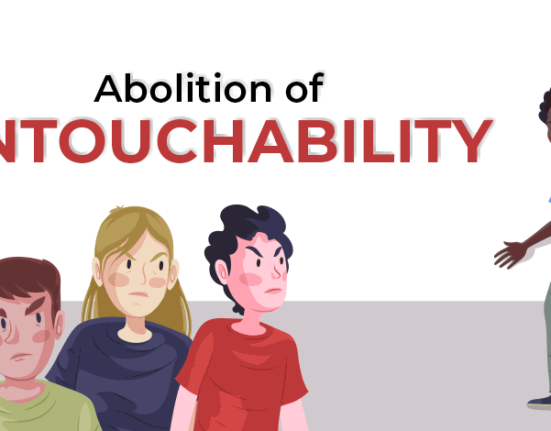Reservation In India: By: Amrutha valli
Introduction:
- India’s age-old caste system is responsible for establishing the reservation system in the country.
- Simply put, it is about making it easier for certain sections of the population to have access to seats in government jobs, educational institutions and even legislatures.
- These sections, owing to their caste identity, have faced historical injustice.
- The reservation may also be seen as positive discrimination as a quota-based affirmative action.
- It is ruled in India by government policies backed by the Constitution of India.
History of Reservation In India
- The definition of the caste-based quota system was first formulated by William Hunter and Jyotirao Phule in 1882.
- In 1933, when British Prime Minister Ramsay Macdonald proposed the ‘Communal Prize’, the reservation structure that remains today, in its true meaning, was implemented.
- The award made provision for Muslims, Sikhs, Indian Christians, Anglo-Indians, Europeans and the Dalits for separate voters.
- Gandhi and Ambedkar signed the ‘Poona Pact’ after lengthy talks, where it was agreed that there would be a single Hindu electorate with some reservations within it.
- After independence, only SCs and STs were initially issued with reservations.
- On the recommendations of the Mandal Committee, OBCs were included in the scope of the reservation in 1991.
- The Supreme Court, while upholding the 27 per cent quota for backward classes, struck down the government notification in the Indra Sawhney Case of 1992, reserving 10 per cent of government employment among the upper castes for economically backward classes.
- In the same case, the Supreme Court has affirmed the principle that the combined beneficiaries of the reservation could not cross 50 per cent of the Indian population.
- Via this decision and provision, the idea of ‘creamy sheet’ has acquired currency that reservations for backward classes should be limited only to initial appointments and not apply to promotions.
- Recently, in the unreserved group, the Constitutional (103rd Amendment) Act of 2019 has provided 10% quota for the “economically backward” in government employment and educational institutions.
- The Act amends Articles 15 and 16 of the Constitution by inserting provisions that allow the government, on the grounds of economic backwardness, to provide reservations.
Mandal commission:
- In the exercise of the powers bestowed by Article 340 of the Constitution, in December 1978, under the chairmanship of B, the President constituted the Backward Class Board. From P. Mandal.
- The commission was created to decide the requirements for identifying the “socially and educationally backward classes” of India and to prescribe measures to be taken to advance those classes.
- The Mandal Commission concluded that the population of India consisted of roughly 52% of OBCs, so they could be reserved for 27% of government employment.
- Eleven social, educational, and economic backwardness metrics have been established by the commission.
- The Commission has also defined backward classes among non-Hindus (e.g. Muslims, Sikhs, Christians, and Buddhists), in addition to identifying backward classes among Hindus.
- It created an all-India list of 3,743 castes of other backward classes (OBC) and a more underprivileged list of 2,108 castes of “depressed backward classes.”
- This economic reservation of 10 percent is above and above the 50 percent reservation limit.
Constitutional Rules governing Indian reservations
- In the Federal and State assemblies, Section XVI deals with SC and ST reservations.
- Article 15(4) and 16(4) of the Constitution authorize the State and Central Governments to reserve seats for representatives of the SC and ST in government services.
- The Constitution was modified by the 1995 Constitution (77th Amendment) Act, and a new provision (4A) was added in Article 16 to allow the government to make promotional reservations.
- Subsequently, clause (4A) was revised by the Constitution (85th Amendment) Act, 2001 to include SC and ST candidates promoted by reservation with consequential seniority.
- Article 16(4 B) was introduced in the Constitutional 81st Amendment Act, 2000, enabling the State to fill the unfilled vacancies of a year reserved for SCs/STs in the next year, thus nullifying the limit of the fifty percent reservation on the overall number of vacancies of that year.
- Special representation by allocation of seats for SCs and STs in Parliament and in the State Legislative Assemblies is provided for in Article 330 and 332.
- The reservation of seats for SCs and STs in each Panchayat is provided in Article 243D.
- Article 233T provides for the allocation of seats in a municipality for SCs and STs.
- Article 335 of the Constitution specifies that, for the preservation of the effectiveness of administration, the arguments of STs and STs shall be taken constitutively into account.
Judicial scrutiny of Reservation In India
- The first big decision of the Supreme Court on the issue of reservation in India was the State of Madras v. Smt. Champakam Dorairajan (1951) case. The case led to the first constitutional amendment.
- In that case, the Supreme Court found out that while Article 16(4) allows for reservations in favour of a backward class of people in the case of jobs pursuant to the State, no such provision was made in Article 15.
- The Parliament modified Article 15 in compliance with the order of the Supreme Court in the case by adding Clause 15 (4).
- The court investigated the nature and degree of Article 16 in the Indra Sawhney v. Union of India (1992) case (4).
- The Court ordered that the creamy layer of OBCs should be removed from the list of reservation applicants, promotions should not be reserved, and the overall reserved quota should not exceed 50 percent.
- In reaction, Parliament passed the 77th Constitutional Amendment Act, which adopted Article 16 (4A).
- The article grants the state the right to assign seats in favour of SC and ST in civil sector promotions, until the groups are sufficiently served in public jobs.
- The High Court in M. In the 2006 case of Nagaraj v. Union Of India, while upholding the constitutional validity of Article 16(4A), it was held that, in order to be constitutionally legitimate, any such reservation scheme would meet the following three constitutional requirements:
- The society of the SC and ST should be backward economically and educationally.
- Public jobs is not properly reflected by the SC and ST groups.
- This reservation scheme should not impact the overall productivity of the government.
- In the 2018 case of Jarnail Singh vs Lachhmi Narain Gupta, the Supreme Court held that promotion reservations do not enable the state to gather quantifiable data on the backwardness of the Scheduled Castes and the Scheduled Tribes.
- The Court ruled that the prohibition of the creamy layer applies to SC/STs and, thus, the State does not give promotion reservations to SC/ST persons who belong to their community’s creamy layer.
- The Supreme Court upheld the Karnataka legislation in May 2019 that requires reservations for SCs and STs with consequential seniority in promotions.
Why reservation is needed?
- To correct the historical inequality confronted in the world by backward castes.
- To provide the backward segment with a level playing field, since they cannot contend with those who have for decades had access to wealth and means.
- To ensure that the backward classes are properly served in facilities under the Administration.
- Backward grades for progression.
- Before judging them on the grounds of competence, all persons must be taken to the same degree in order to guarantee dignity as a basis for meritocracy.
Claim Against Reservation in India
- State service reservations led to divisions and enmity among government workers, vitiating the workplace environment.
- The goal of the reservation policy was eradication, not caste perpetuation, but Caste Centered Reservation just perpetuates the notion of caste in society.
- Reservations were placed in motion to ensure that fair access to resources was provided to the economically underprivileged populations, but they continue to be economically marginalized because of economic development.
- In order to decide the best but the most backward, reservation kills self-respect, so the rivalry is no longer on.
- The greatest opponent of meritocracy, which is the backbone of many modern nations, is reservations.
- By referencing class loyalties and primordial identities, it has become a vehicle for meeting narrow political ends.
- The advantages of reservation have been appropriated by the ruling and elite class within the backward castes and the most oppressed within the backward castes have remained marginalized.
- Instead of inclusion, reservation has been the tool of exclusion when many upper caste poor still face inequality and oppression that creates discontent in society.
Reasons behind rising reservation requests
- Reservation is increasingly used as a solution for the detrimental consequences of planning plans that are ill-thought out.
- In developing states, such as Haryana, Gujarat and Maharashtra, three factors have troubled people, despite their economies being comparatively better:
- Agrarian Extreme Pain,
- Stagnation in the development of jobs and
- Distortions in the trajectory of growth.
- It is better for policymakers to speak about reservations in this way than to make a course correction.
- Increasing demands for reservations among upper castes often derive from the fear of losing privilege and the inability to live with change
- Particularly in the form of government employment, upper castes have begun to feel inferior as they do not earn equal advantages as backward classes.
Suggestions:
- To the vast majority of underprivileged children from backward castes, the quota benefits should flow; not to a few fortunate children with a caste suffix.
- Families of high-ranking politicians, high-paid workers, and those above a certain income should not enjoy reservation benefits, especially in government employment.
- It is feasible and appropriate to provide equal and realistic ways to assist vulnerable people from each group by reservations.
- The reservation process should root out the genuinely economically disadvantaged people and put them all to justice.
- It takes an hour to make revolutionary improvements to the education sector at the grass-roots level.
- Knowledge generation is also important because as the unreserved segments continue to reject the provision, the neediest sections within the reserved segments are hardly aware of how to benefit from the provision or even whether there are any provisions.
Way ahead: Reservation In India
- Reservation in India is fair to the extent that, for the benefit of the downtrodden and economically backward sections of society, it provides appropriate positive discrimination.
- Yet it should be done away with as soon as possible if it appears to damage society and guarantees privileges for those at the detriment of others for limited political ends.
- The groups excluded harbor hostility from reservations and bigotry towards the castes included in the list of reservation.
- The nation itself stagnates as more persons aspire to backwardness instead of forwardness.
- Meritocracy should not be polluted by the injection of relaxation of entrance restrictions, rather than by the allocation of financial assistance to the poor.
- In order to strike a balance between backward fairness, equality for the future and productivity for the whole system, a powerful political will is necessary.
Also Read: Fundamental Rights And Supreme Court’s Views






Leave feedback about this